The Three Dimensions of Small Accommodation Businesses and Their Efficiency
Abstract
1. Introduction
- What is the efficiency level of small accommodation businesses considering the three dimensions of the family business as DEA model variables?
- Is the resulting efficiency influenced by factors that are related to the manager, business, and ownership form?
2. Literature Review
3. Materials and Methods
3.1. Study Area
3.2. Data Envelopment Analysis
3.3. Truncated Regression Model
- : the dependent variable, corrected efficiency;
- : the environmental factors affecting efficiencies;
- β: the coefficient linking the independent and dependent variable;
- : independent term indicating potential error.
- For i = 1, 2, …, M, randomly select from the normal distribution N(0,) with left Truncation ;
- Execution of the equation: ;
- Set for each i = 1, 2, …, M;
- Run for each i = 1, 2, …, M with substitution .
- For i = 1, 2, …, M, select from with left Truncation ;
- For i = 1, 2, …, M, execute the equation ;
- To find , the ML method is used.
4. Results
5. Discussion
6. Conclusions
Author Contributions
Funding
Informed Consent Statement
Data Availability Statement
Acknowledgments
Conflicts of Interest
References
- Langvinienė, N.; Daunoravičiūtė, I. Factors Influencing the Success of Business Model in the Hospitality Service Industry. Procedia-Soc. Behav. Sci. 2015, 213, 902–910. [Google Scholar] [CrossRef]
- Dimitriadou, E.; Bournaris, T.; Stavrinoudis, T.; Iakovidou, O. The efficiency score of small accommodation businesses in non-coastal rural areas in Greece. Sustainability 2021, 13, 11005. [Google Scholar] [CrossRef]
- Pulina, M.; Detotto, C.; Paba, A. An investigation into the relationship between size and efficiency of the Italian hospitality sector: A window DEA approach. Eur. J. Oper. Res. 2010, 204, 613–620. [Google Scholar] [CrossRef]
- Jones, N.; Lee-Ross, D.; Ingram, H. A study of service quality in small hotels and guesthouses. Prog. Tour. Hosp. Res. 1997, 3, 351–363. [Google Scholar] [CrossRef]
- Getz, D.; Carlsen, J. Characteristics and goals of family and owner-operated businesses in the rural tourism and hospitality sectors. Tour. Manag. 2000, 21, 547–560. [Google Scholar] [CrossRef]
- Ivanov, S.; Zhechev, V. Hotel revenue management—A critical literature review. Tour. Int. Interdiscip. J. 2012, 60, 175–197. [Google Scholar] [CrossRef][Green Version]
- Yang, Y.; Luo, H.; Law, R. Theoretical, empirical, and operational models in hotel location research. Int. J. Hosp. Manag. 2014, 36, 209–220. [Google Scholar] [CrossRef]
- Peters, M.; Kallmuenzer, A. Entrepreneurial orientation in family firms: The case of the hospitality industry. Curr. Issues Tour. 2015, 21, 21–40. [Google Scholar] [CrossRef]
- Pavić, L.; Blešić, I.; Nerandžić, B.; Vukosav, S.; Mumel, D. Motels in Serbia: What do potential guests expect? Industrija 2018, 46, 65–76. [Google Scholar] [CrossRef]
- Pavić, L.; Veljković, B.; Sešel, B. Discriminant Analysis—Useful Tool for Predicting Demand in Serbian Motels. Econ. Themes 2018, 56, 503–517. [Google Scholar] [CrossRef]
- Waheed, N.; Hassan, Z. Influence of Customer Perceived Value on Tourist Satisfaction and Revisit Intention: A study on Guesthouses in Maldives. Int. J. Account. Bus. Manag. 2016, 4, 98–119. [Google Scholar] [CrossRef]
- Radder, L.; Wang, Y. Dimensions of guest house service: Managers’ perceptions and business travellers’ expectations. Int. J. Contemp. Hosp. Manag. 2006, 18, 554–562. [Google Scholar] [CrossRef]
- Fehrest, F.; Sadry, B.N.; Pour, F.S. The Effect of User-Generated Contents on Travelers’ Selection of Environmentally Friendly Guesthouses; Emerald Publishing Limited: Bingley, UK, 2020. [Google Scholar] [CrossRef]
- Barbieri, C.; Mshenga, P.M. The Role of the Firm and Owner Characteristics on the Performance of Agritourism Farms. Sociol. Rural. 2008, 48, 166–183. [Google Scholar] [CrossRef]
- Symeonidou, P. The Competitiveness and Sustainability of Agritourism Companies in Greece; Aristotle University of Thessaloniki: Thessaloniki, Greek, 2009. (In Greek) [Google Scholar]
- Arru, B.; Furesi, R.; Madau, F.A.; Pulina, P. Recreational Services Provision and Farm Diversification: A Technical Efficiency Analysis on Italian Agritourism. Agriculture 2019, 9, 42. [Google Scholar] [CrossRef]
- Guttentag, D. Airbnb: Disruptive innovation and the rise of an informal tourism accommodation sector. Curr. Issues Tour. 2015, 18, 1192–1217. [Google Scholar] [CrossRef]
- Zervas, G.; Proserpio, D.; Byers, J. The rise of the sharing economy: Estimating the impact of airbnb on the hotel industry. J. Mark. Res. 2017, 54, 687–705. [Google Scholar] [CrossRef]
- Adamiak, C. Current state and development of Airbnb accommodation offer in 167 countries. Curr. Issues Tour. 2019, 25, 3131–3149. [Google Scholar] [CrossRef]
- Alberca, P.; Parte, L. Efficiency in the Holiday and Other Short-Stay Accommodation Industry. Sustainability 2020, 12, 9493. [Google Scholar] [CrossRef]
- Law, R.; Leung, D.; Cheung, C. A Systematic Review, Analysis, and Evaluation of Research Articles in the Cornell Hospitality Quarterly. Cornell Hotel. Restaur. Adm. Q. 2012, 53, 365–381. [Google Scholar] [CrossRef]
- Perrigot, R.; Cliquet, G.; Piot-Lepetit, I. Plural form chain and efficiency: Insights from the French hotel chains and the DEA methodology. Eur. Manag. J. 2009, 27, 268–280. [Google Scholar] [CrossRef]
- Luo, H.; Yang, Y.; Law, R. How to achieve a high efficiency level of the hotel industry? Int. J. Contemp. Hosp. Manag. 2014, 26, 1140–1161. [Google Scholar] [CrossRef]
- Oukil, A.; Channouf, N.; Al-Zaidi, A. Performance evaluation of the hotel industry in an emerging tourism destination: The case of Oman. J. Hosp. Tour. Manag. 2016, 29, 60–68. [Google Scholar] [CrossRef]
- Poldrugovac, K.; Tekavcic, M.; Jankovic, S. Efficiency in the hotel industry: An empirical examination of the most influential factors. Econ. Res. Istraz. 2016, 29, 583–597. [Google Scholar] [CrossRef]
- Wang, F.-C.; Hung, W.-T.; Shang, J.-K. Measuring the cost efficiency of international tourist hotels in Taiwan. Tour. Econ. 2006, 12, 65–85. [Google Scholar] [CrossRef]
- Assaf, A.G.; Agbola, F.W. Modelling the performance of australian hotels: A DEA double bootstrap approach. Tour. Econ. 2011, 17, 73–89. [Google Scholar] [CrossRef]
- Hathroubi, S.; Peypoch, N.; Robinot, E. Technical efficiency and environmental management: The Tunisian case. J. Hosp. Tour. Manag. 2014, 21, 27–33. [Google Scholar] [CrossRef]
- Koutsouris, A.; Gidarakou, I.; Grava, F.; Michailidis, A. The phantom of (agri)tourism and agriculture symbiosis? A Greek case study. Tour. Manag. Perspect. 2014, 12, 94–103. [Google Scholar] [CrossRef]
- De Jorge, J.; Suárez, C. Productivity, efficiency and its determinant factors in hotels. Serv. Ind. J. 2014, 34, 354–372. [Google Scholar] [CrossRef]
- Chaabouni, S. China’s regional tourism efficiency: A two-stage double bootstrap data envelopment analysis. J. Destin. Mark. Manag. 2019, 11, 183–191. [Google Scholar] [CrossRef]
- Tan, Y.; Despotis, D. Investigation of efficiency in the UK hotel industry: A network data envelopment analysis approach. Int. J. Contemp. Hosp. Manag. 2021, 33, 1080–1104. [Google Scholar] [CrossRef]
- Gersick, K.E.; Davis, J.A.; McCollom Hampton, M.M.; Landsberg, I. Generation to Generation: Life Cycles of the Family Business; Harvard Business School Press: Boston, MA, USA, 1997. [Google Scholar]
- Wilson, L. The Family Farm Business? Insights into Family, Business and Ownership Dimensions of Open-Farms. Leis. Stud. 2007, 26, 357–374. [Google Scholar] [CrossRef]
- Daliborka, B. The Three Dimensional Development Model of Family Business. J. Bus. Econ. Policy 2017, 4, 51–54. [Google Scholar]
- Engeset, A.B. “For better or for worse”—The role of family ownership in the resilience of rural hospitality firms. Scand. J. Hosp. Tour. 2020, 20, 68–84. [Google Scholar] [CrossRef]
- Li, T.; Liu, J.; Zhu, H.; Zhang, S. Business characteristics and efficiency of rural tourism enterprises: An empirical study from China. Asia Pac. J. Tour. Res. 2018, 23, 549–559. [Google Scholar] [CrossRef]
- Minett, D.; Yaman, H.R.; Denizci, B. Leadership styles and ethical decision-making in hospitality management. Int. J. Hosp. Manag. 2009, 28, 486–493. [Google Scholar] [CrossRef]
- Shang, J.-K.; Wang, F.-C.; Hung, W.-T. A stochastic DEA study of hotel efficiency. Appl. Econ. 2010, 42, 2505–2518. [Google Scholar] [CrossRef]
- Fotiadis, A.K.; Vassiliadis, C.A.; Piper, L.A. Measuring Dimensions of Business Effectiveness in Greek Rural Tourism Areas. J. Hosp. Mark. Manag. 2014, 23, 21–48. [Google Scholar] [CrossRef]
- Teodoro, A.; Dinis, I.; Simões, O.; Gomes, G. Success factors for small rural tourism units: An exploratory study in the portuguese region of serra da estrela. Eur. J. Tour. Res. 2017, 17, 136–148. [Google Scholar] [CrossRef]
- Mokhber, M.; Gi, T.G.; Rasid, S.Z.A.; Vakilbashi, A.; Zamil, N.M.; Seng, Y.W. Succession planning and family business performance in SMEs. J. Manag. Dev. 2017, 36, 330–347. [Google Scholar] [CrossRef]
- Pikkemaat, B.; Zehrer, A. Innovation and service experiences in small tourism family firms. Int. J. Cult. Tour. Hosp. Res. 2016, 10, 343–360. [Google Scholar] [CrossRef]
- Getz, D.; Carlsen, J.; Morrison, A. The Family Business in Tourism and Hospitality; CABI: London, UK, 2004. [Google Scholar]
- Kefalas, A. Family Businesses in the New Economy; KRITIKI: Athens, Greece, 2008. (In Greek) [Google Scholar]
- Holt, D.T.; Pearson, A.W.; Carr, J.C.; Barnett, T. Family Firm(s) Outcomes Model: Structuring Financial and Nonfinancial Outcomes across the Family and Firm. Fam. Bus. Rev. 2017, 30, 182–202. [Google Scholar] [CrossRef]
- Veeck, G.; Hallett, L.; Che, D.; Veeck, A. The Economic Contributions of Agricultural Tourism in Michigan. Geogr. Rev. 2016, 106, 421–440. [Google Scholar] [CrossRef]
- Deakins, D.; Freel, M. Entrepreneurship and Small Firms, 2nd ed.; Pekka-Oikonomou, V., Chatzidimitriou, I., Eds.; Rosili: Athens, Greece, 2017. (In Greek) [Google Scholar]
- Nieto, J.; Hernández-Maestro, R.M.; Muñoz-Gallego, P.A. The Influence of Entrepreneurial Talent and Website Type on Business Performance by Rural Tourism Establishments in Spain. Int. J. Tour. Res. 2011, 13, 17–31. [Google Scholar] [CrossRef]
- Dubois, C.; Cawley, M.; Schmitz, S. The tourist on the farm: A ‘muddled’ image. Tour. Manag. 2017, 59, 298–311. [Google Scholar] [CrossRef]
- Ministry of Rural Development and Food. 2021. Available online: http://www.minagric.gr/index.php/el/for-farmer-2/mhtroo-agroton (accessed on 25 November 2022).
- Theodoridis, A.; Batzios, C.; Ragkos, A.; Angelidis, P. Technical efficiency measurement of mussel aquaculture in Greece. Aquac. Int. 2017, 25, 1025–1037. [Google Scholar] [CrossRef]
- Parte-Esteban, L.; Alberca-Oliver, P. Determinants of technical efficiency in the Spanish hotel industry: Regional and corporate performance factors. Curr. Issues Tour. 2015, 18, 391–411. [Google Scholar] [CrossRef]
- Chiang, W.-E.; Tsai, M.-H.; Wang, L.S.-M. A DEA Evaluation of Taipei Hotels. Ann. Tour. Res. 2004, 31, 712–715. [Google Scholar] [CrossRef]
- Haugland, S.A.; Myrtveit, I.; Nygaard, A. Market orientation and performance in the service industry: A data envelopment analysis. J. Bus. Res. 2007, 60, 1191–1197. [Google Scholar] [CrossRef]
- Yu, M.-M.; Lee, B.C. Efficiency and effectiveness of service business: Evidence from international tourist hotels in Taiwan. Tour. Manag. 2009, 30, 571–580. [Google Scholar] [CrossRef]
- Manasakis, C.; Apostolakis, A.; Datseris, G. Using data envelopment analysis to measure hotel efficiency in Crete. Int. J. Contemp. Hosp. Manag. 2013, 25, 510–535. [Google Scholar] [CrossRef]
- Parte, L.; Alberca, P. Business performance and sustainability in cultural and rural tourism destinations. Mathematics 2021, 9, 892. [Google Scholar] [CrossRef]
- Simar, L.; Wilson, P.W. Estimation and inference in two-stage, semi-parametric models of production processes. J. Econom. 2007, 136, 31–64. [Google Scholar] [CrossRef]
- Ye, S.; Xiao, H.; Zhou, L. Small accommodation business growth in rural areas: Effects on guest experience and financial performance. Int. J. Hosp. Manag. 2020, 76, 29–38. [Google Scholar] [CrossRef]
- Kallmuenzer, A.; Peters, M.; Buhalis, D. The role of family firm image perception in host-guest value co-creation of hospitality firms. Curr. Issues Tour. 2019, 23, 2410–2427. [Google Scholar] [CrossRef]
- Ministry of Tourism. Available online: https://mintour.gov.gr/meletes-pinakes/stoicheia-mite/ (accessed on 5 February 2018).
- Region of Central Macedonia. Available online: https://www.pkm.gov.gr/ (accessed on 5 April 2020).
- Eurostat. Glossaty: Coastal Area. 2020. Available online: https://ec.europa.eu/eurostat/statistics-explained/index.php/Glossary:Coastal_area (accessed on 18 August 2020).
- Kouriati, A.; Dimitriadou, E.; Bournaris, T. Farm accounting for farm decision making: A case study in Greece. Int. J. Sustain. Agric. Manag. Inform. 2021, 7, 77. [Google Scholar] [CrossRef]
- Chatzitheodoridis, F.; Kontogeorgos, A. Exploring of a Small-Scale Tourism Product under Economic Instability: The Case of a Greek Rural Border Area. Economies 2020, 8, 52. [Google Scholar] [CrossRef]
- Barros, C.P.; Chen, Z.; Bin Liang, Q.; Peypoch, N. Technical efficiency in the Chinese banking sector. Econ. Model. 2011, 28, 2083–2089. [Google Scholar] [CrossRef]
- Barros, C.P.; Nektarios, M.; Assaf, A. Efficiency in the Greek insurance industry. Eur. J. Oper. Res. 2010, 205, 431–436. [Google Scholar] [CrossRef]
- Bournaris, T.; Vlontzos, G.; Moulogianni, C. Efficiency of vegetables produced in Glasshouses: The Impact of Data Envelopment Analysis (DEA) in land management decision making. Land 2019, 8, 17. [Google Scholar] [CrossRef]
- Prentzas, A.; Nastis, S.A.; Moulogianni, C.; Kouriati, A. Technical and economic analysis of farms cultivating cereals and legumes: A Greek case study. Int. J. Sustain. Agric. Manag. Inform. 2022, 8, 446. [Google Scholar] [CrossRef]
- Oliveira, R.; Pedro, M.I.; Marques, R.C. Efficiency performance of the Algarve hotels using a revenue function. Int. J. Hosp. Manag. 2013, 35, 59–67. [Google Scholar] [CrossRef]
- Dobrovič, J.; Čabinová, V.; Gallo, P.; Partlová, P.; Váchal, J.; Balogová, B.; Orgonáš, J. Application of the dea model in tourism smes: An empirical study from slovakia in the context of business sustainability. Sustainability 2021, 13, 7422. [Google Scholar] [CrossRef]
- Kounetas, K.; Papathanassopoulos, F. How efficient are Greek hospitals? A case study using a double bootstrap DEA approach. Eur. J. Health Econ. 2013, 14, 979–994. [Google Scholar] [CrossRef]
- Neves, J.C.; Lourenço, S. Using data envelopment analysis to select strategies that improve the performance of hotel companies. Int. J. Contemp. Hosp. Manag. 2009, 21, 698–712. [Google Scholar] [CrossRef]
- Lado-Sestayo, R.; Fernández-Castro, S. The impact of tourist destination on hotel efficiency: A data envelopment analysis approach. Eur. J. Oper. Res. 2019, 272, 674–686. [Google Scholar] [CrossRef]
- Assaf, A.G.; Tsionas, M. Measuring hotel performance: Toward more rigorous evidence in both scope and methods. Tour. Manag. 2018, 69, 69–87. [Google Scholar] [CrossRef]
- Arbelo, A.; Pérez-Gómez, P.; Arbelo-Pérez, M. Estimating efficiency and its determinants in the hotel sector using a profit function. Curr. Issues Tour. 2018, 21, 863–876. [Google Scholar] [CrossRef]
- Karampela, S.; Kizos, T.; Spilanis, I. Evaluating the impact of agritourism on local development in small islands. Isl. Stud. J. 2016, 11, 161–176. [Google Scholar] [CrossRef]
- Karampela, S.; Kizos, T. Agritourism and local development: Evidence from two case studies in Greece. Int. J. Tour. Res. 2018, 20, 566–577. [Google Scholar] [CrossRef]
- Tafidou, A.; Lialia, E.; Prentzas, A.; Kouriati, A.; Dimitriadou, E.; Moulogianni, C.; Bournaris, T. Land Diversification and Its Contribution to Farms’ Income. Land 2023, 12, 911. [Google Scholar] [CrossRef]
- Konstantakopoulou, I. Does Health Quality Affect Tourism? Evidence from System GMM Estimates. Econ. Anal. Policy 2022, 73, 425–440. [Google Scholar] [CrossRef]
- Szolnoki, G.; Tafel, M. Environmental Sustainability and Tourism—The Importance of Organic Wine Production for Wine Tourism in Germany. Sustainability 2022, 14, 11831. [Google Scholar] [CrossRef]
- Perles-Ribes, J.F.; Ramon-Rodriguez, A.B.; Such-Devesa, M.J.; Moreno-Izquierdo, L. Effects of Political Instability in Consolidated Destinations: The Case of Catalonia (Spain). Tour. Manag. 2019, 70, 134–139. [Google Scholar] [CrossRef]
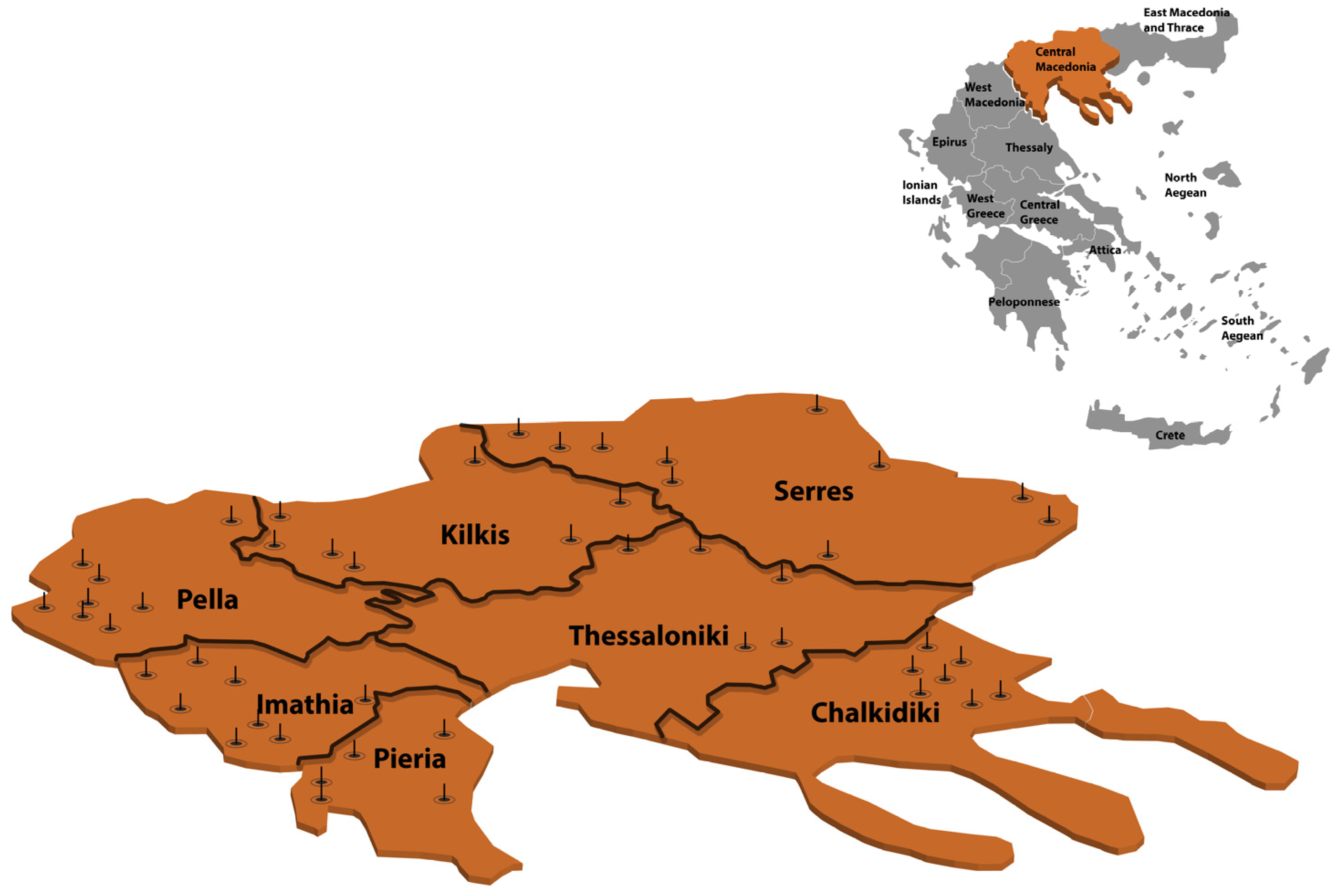
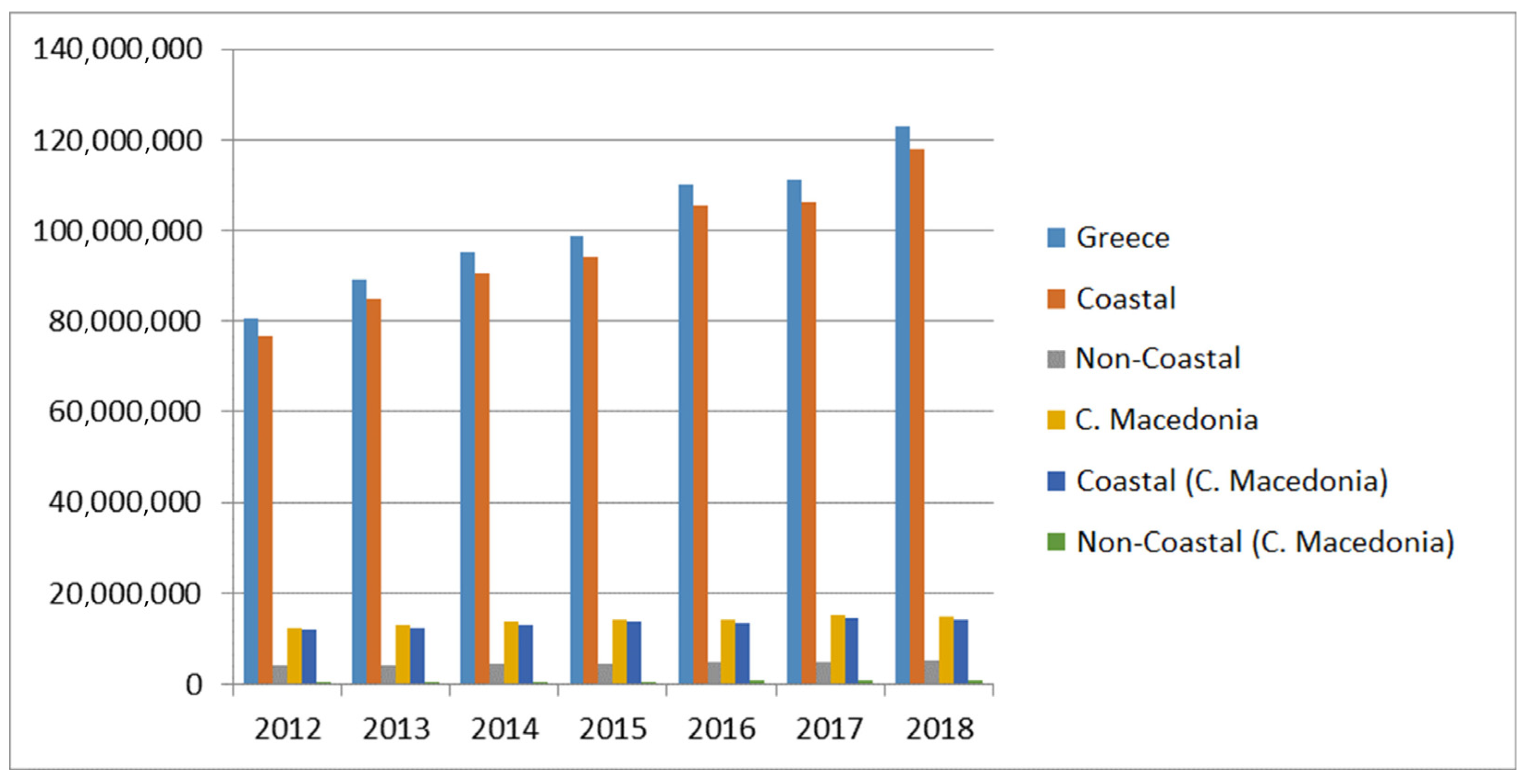
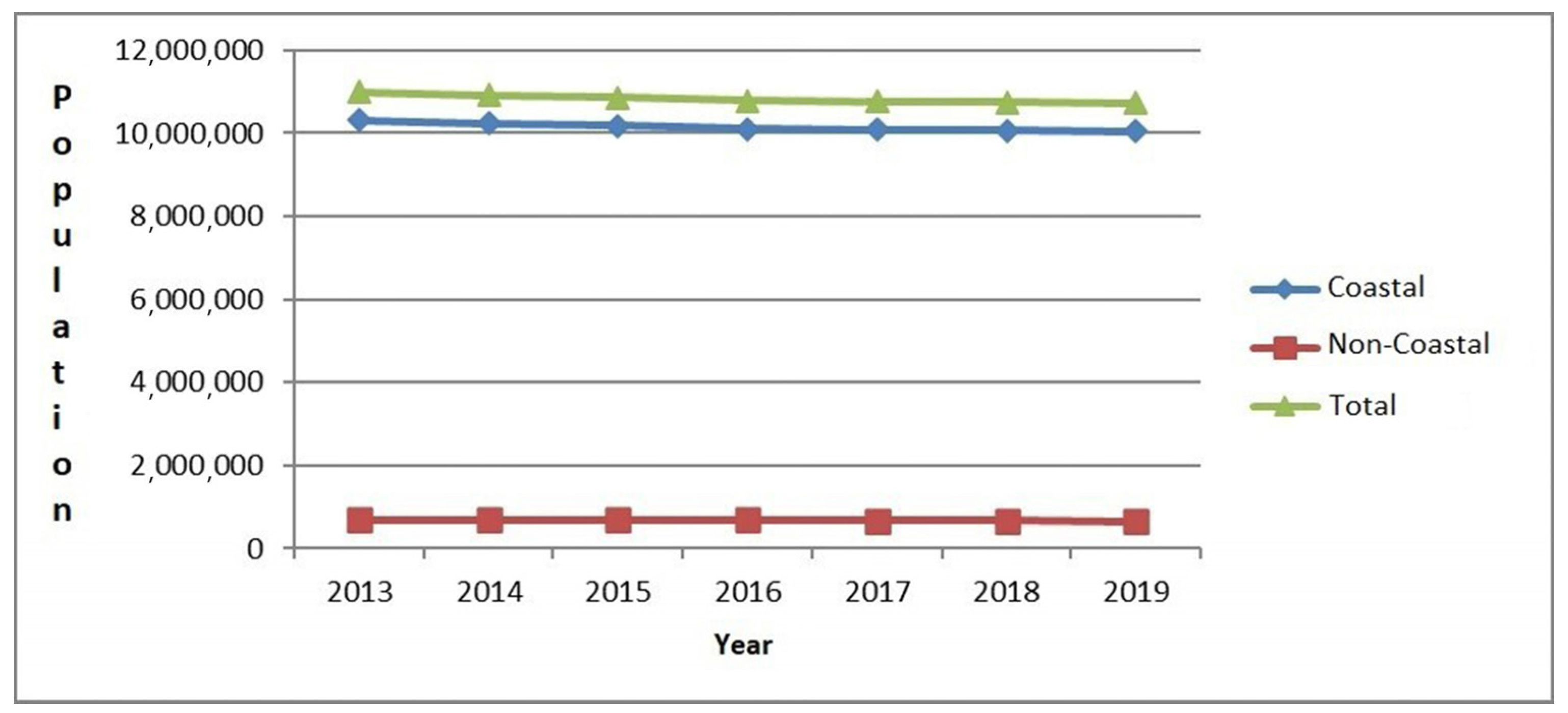
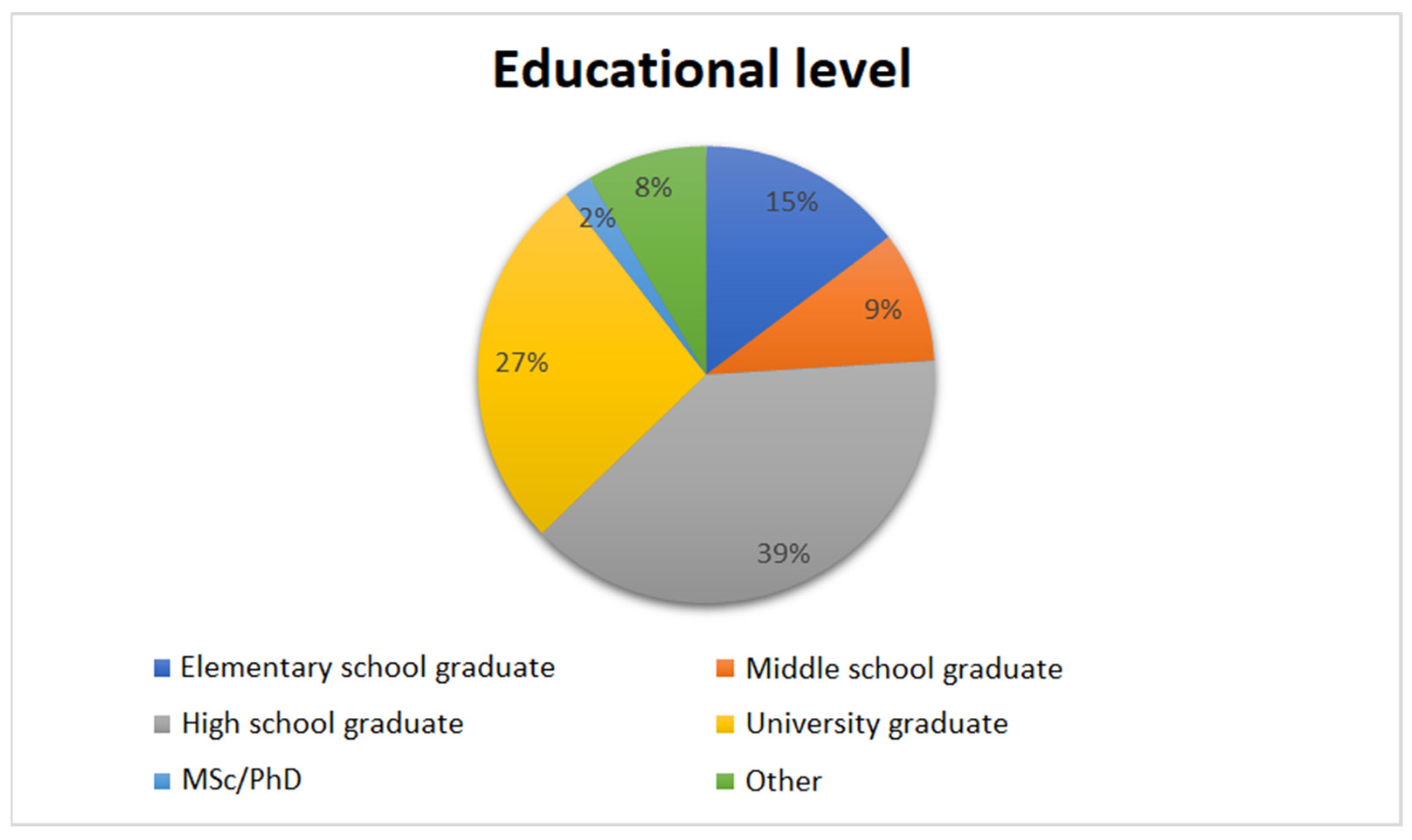
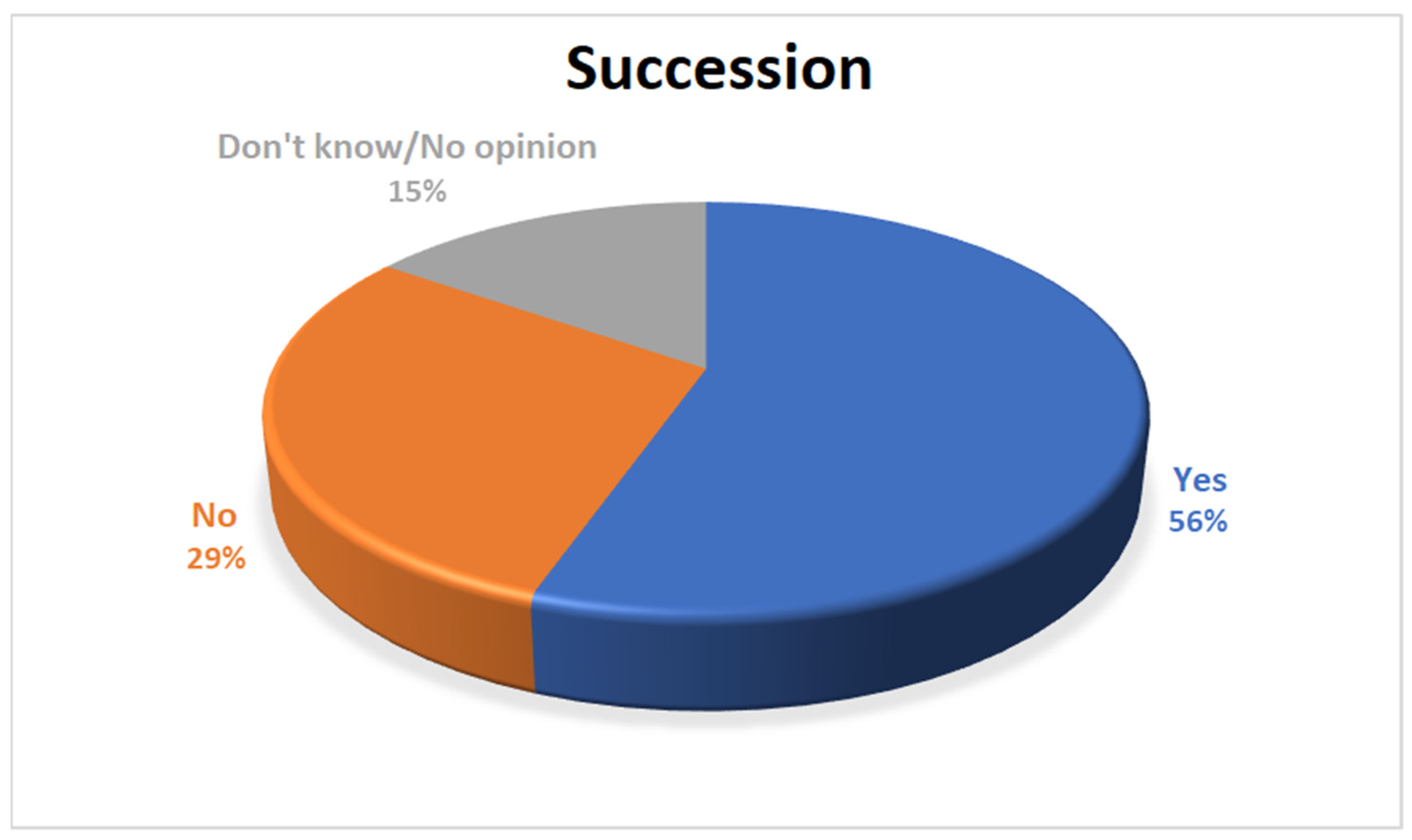
| Variables Table | Mean | SD | Min | Max |
|---|---|---|---|---|
| Outputs and Inputs/DEA Variables | ||||
| Total revenue (EUR) | 63,348 | 66,258 | 900 | 360,000 |
| Family members (number) | 2 | 1.3 | 1 | 8 |
| Total expenses (EUR) | 29,368 | 27,321 | 640 | 173,207 |
| Value of assets (EUR) | 383,882 | 29,397 | 0 | 1,480,000 |
| Business-Specific Variables/Truncated Regression Model Variables | ||||
| Business’s age (year) | 13 | 7 | 1 | 51 |
| Manager’s age (year) | 49 | 11 | 23 | 83 |
| Variables | 1 | 2 |
|---|---|---|
| Ownership (1 = Rent 2 = Own) | 10.7% | 89.3% |
| Sex (1 = Male 2 = Female) | 62.0% | 38.0% |
| Agricultural Activities (1 = Yes 2 = No) | 40.7% | 59.3% |
| Business Type (1 = Simple 2 = Complex) | 52.7% | 47.3% |
| Scores | VRS | |||
|---|---|---|---|---|
| Mean | SD | Min | Max | |
| Efficiency | 0.493 | 0.286 | 0.033 | 1 |
| Bootstrapped Efficiency | 0.405 | 0.219 | 0.024 | 0.837 |
| Efficiency Score | DEA | Bootstrap DEA | ||
|---|---|---|---|---|
| Number of Businesses | % of Businesses | Number of Businesses | % of Businesses | |
| 0–0.59 | 101 | 67.3 | 111 | 74.0 |
| 0.60–0.79 | 22 | 14.7 | 33 | 22.0 |
| 0.80–0.991 | 9 | 6.0 | 6 | 4.0 |
| =1 | 18 | 12.0 | 0 | 0.0 |
| Total | 150 | 100.0 | 150 | 100.0 |
| Explanatory Variables | Coefficient | LB * | UB ** |
|---|---|---|---|
| Agricultural activities | −0.217 | −0.545 | 0.221 |
| Business type | 1.178 | 0.965 | 1.723 |
| Business’s age | 0.018 | −0.007 | 0.047 |
| Manager’s age | −0.381 | −0.628 | −0.027 |
| Education | 0.025 | −0.104 | 0.183 |
| Succession | −0.004 | −0.016 | 0.017 |
| Sex | −0.304 | −0.620 | 0.119 |
| Ownership | 0.343 | 0.179 | 1.346 |
Disclaimer/Publisher’s Note: The statements, opinions and data contained in all publications are solely those of the individual author(s) and contributor(s) and not of MDPI and/or the editor(s). MDPI and/or the editor(s) disclaim responsibility for any injury to people or property resulting from any ideas, methods, instructions or products referred to in the content. |
© 2023 by the authors. Licensee MDPI, Basel, Switzerland. This article is an open access article distributed under the terms and conditions of the Creative Commons Attribution (CC BY) license (https://creativecommons.org/licenses/by/4.0/).
Share and Cite
Dimitriadou, E.; Kouriati, A.; Karampela, S.; Tafidou, A.; Bournaris, T. The Three Dimensions of Small Accommodation Businesses and Their Efficiency. Tour. Hosp. 2023, 4, 467-482. https://doi.org/10.3390/tourhosp4030029
Dimitriadou E, Kouriati A, Karampela S, Tafidou A, Bournaris T. The Three Dimensions of Small Accommodation Businesses and Their Efficiency. Tourism and Hospitality. 2023; 4(3):467-482. https://doi.org/10.3390/tourhosp4030029
Chicago/Turabian StyleDimitriadou, Eleni, Asimina Kouriati, Sofia Karampela, Anna Tafidou, and Thomas Bournaris. 2023. "The Three Dimensions of Small Accommodation Businesses and Their Efficiency" Tourism and Hospitality 4, no. 3: 467-482. https://doi.org/10.3390/tourhosp4030029
APA StyleDimitriadou, E., Kouriati, A., Karampela, S., Tafidou, A., & Bournaris, T. (2023). The Three Dimensions of Small Accommodation Businesses and Their Efficiency. Tourism and Hospitality, 4(3), 467-482. https://doi.org/10.3390/tourhosp4030029








